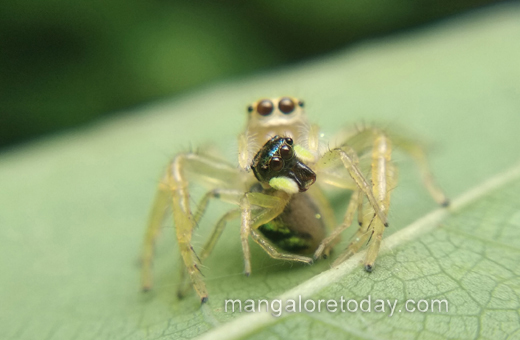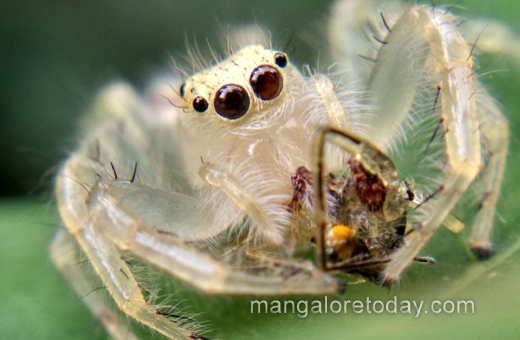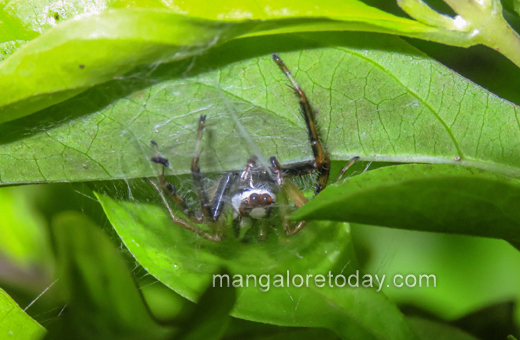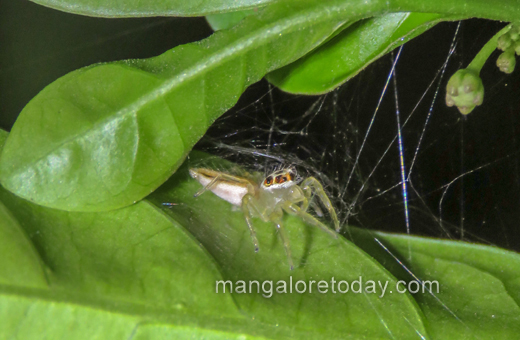
Expertsí spider study published in top international journal
Mangalore Today News Network
Mangaluru, April 19, 2019: A research team led by naturalist and arachnologist Javed Ahmed, along with Moodabidri based environmentalist, surgeon and wildlife enthusiast Dr. Krishna Mohan; Naturalist, Birder, Landrace Dog Expert, & Amateur Arachnologist, Ms. Rajashree Khalap, along with keen naturalist, and macro wildlife photography enthusiast, Mr. Somnath Kumbhar, which has been devoted to the study of Indian spiders has once again endeavoured to bring forth unique findings on yet another species, the two-striped jumper, Telamoniadimidiata, which have been published in the acclaimed international peer-reviewed scientific journal ‘Peckhamia’.

Two-striped jumper feeing on jumping spider of Phintella genus

Two-striped jumper feeding on another jumping spider of Asemonea genus.

Male two-striped jumper in it’s silk retreat, which proects them from their enemies, while providing a safe place to rest.

Female two-striped jumper in it’s silk retreat which proects them from their enemies, while providing a safe place to rest.
Ms. Rajashree Khalap first photographed the delicate retreats of the two-striped jumper in the garden surrounding her holiday home, along the Konkan coast. Upon being told how little was known about the secret-lives of the commonest of our spiders, she took it upon herself to remedy the situation by diligently recording, photographing and monitoring the retreats of three different female two-striped jumpers, upon each subsequent visit to her holiday home, along the Konkan coast.
Somnath B. Kumbhar went through great lengths to painstakingly document instances of araneophagy (or ‘spider eating another spider’, in more simple terms) in the two-striped jumper, using only an inexpensive smart phone camera, jerry rigged with a lens repurposed from a broken camera.
The team collaborated with two renowned international experts Dr. David Hill, a US based authority on jumping spiders, and Dr. Richard Pearce, a British spider expert and ecologist who works closely with IUCN (International Union for Conservation of Nature).
Jumping spiders belong to the spider family Salticidae. With 6115 known species and 636 genera, it is the largest classification of spider families. They are known for their ability for very agile jumps, notably when hunting, responding to threats or while crossing long gaps.The two-striped jumperis a beautiful spider. Despite being easily identified and commonly seen, it is poorly studied, like most spiders found in India.
The present study concerned observational research into the living habits of this spider species. It focused on documenting only two aspects of the spider’s behavior, namely, its use of overnight silk retreats (temporary nests) and collecting records of its predation (hunt). The studies were made largely in the state of Maharashtra, at Nagaon, near Alibaug district. The findings are published in’Peckhamia’ issue dated 25 March, 2019. ’Peckhamia’ is the only journal in the world dedicated solely to publishing scientific research on jumping spiders.
Victim of Hoax
An interesting side story regarding two-striped jumper, Telamoniadimidiata, is that it was once the chief victim of a widespread internet hoax. The fake item which originated long before the days of social media and smart phones, was mainly spread through emails. In the fake message, the reader was ‘warned’ about a dangerous species of spider which hid under toilet seats and bit humans with a highly toxic venom. It ‘alerted’ the readers that many such spiders were found in the toilets of airplanes coming from India and other Asian countries. Dr. Krishna Mohan who is a keen nature photographer too, has debunked these claims in his photography blog. “When we first encountered this hoax in 1999, most readers were able to instantly recognize it as a joke.Later someone rewrotethe hoax message with authentic-sounding details and named Two-Striped Telamoniaas the culprit, while in reality it is a completely harmless spider,” says Dr. Krishna Mohan. “Such pranks evoke fear, spread myths and misunderstanding about nature.”
Dr. Krishna Mohan who is a keen nature photographer too, has debunked these claims in his photography blog. “When we first encountered this hoax in 1999, most readers were able to instantly recognize it as a joke.Later someone rewrotethe hoax message with authentic-sounding details and named Two-Striped Telamoniaas the culprit, while in reality it is a completely harmless spider,” says Dr. Krishna Mohan. “Such pranks evoke fear, spread myths and misunderstanding about nature.”
Importance of the Study
This discovery is important because it sheds more light on the species, which while common, is extremely important to the functioning of our diverse ecosystem. Usually the glamorous animals like tiger and elephant dominate popular imagination. But it is the tiny members of the crawling kingdom - insects, spiders and their kin- which are the cogs and wheels of the ecosystem and keep it functioning in perfect order. These creatures are often overlooked and misunderstood.
The research team has therefore endeavoured to add to our understanding of this harmless little species of jumping spider which plays a vital role in keeping harmful pest species such as flies and mosquitoes in check. “Uncovering new information about this species will not only lead to its better understanding, but also it adds to our knowledge of the natural history and ecology of spiders found in our great country,” says Javed Ahmed, who adds, “We still have a long way to go, and we’ve only just begun to scratch the surface. But it’s a start. Because not knowing, when we easily can, with a little effort, is no longer a luxury we can afford in this day and age of the anthropocene, where global climate change and the resulting species extinction are long past being house-hold terms, and a very stark reality which can no longer be refuted.”